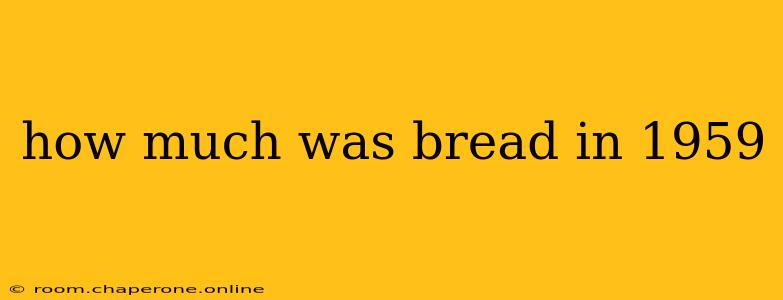The Price of a Loaf: Bread Costs in 1959 and What They Tell Us
The seemingly simple question, "How much was bread in 1959?" opens a window into a fascinating era of American history. While a precise answer depends on factors like location, brand, and type of bread, we can explore the average cost and understand the broader economic context of the time.
Average Bread Prices in 1959:
Pinpointing the exact price of a loaf of bread in 1959 is difficult due to variations across the country and the lack of readily available, nationally standardized price data from that era. However, historical sources suggest that a loaf of white bread typically cost between 18 and 25 cents. This translates to roughly $1.75 to $2.40 in 2024 dollars, accounting for inflation. Keep in mind that this is an estimate; the actual cost could have varied significantly depending on the region and the store. A specialty bread, like rye or sourdough, would likely have been more expensive.
Beyond the Price Tag: Understanding the Economic Climate of 1959
The price of bread in 1959 provides a glimpse into the economic landscape of the post-war era. The 1950s were a period of significant economic growth and prosperity in the United States. However, this prosperity wasn't evenly distributed, and the cost of living, including the price of staple foods like bread, was still a significant concern for many families.
Factors Influencing Bread Prices:
Several factors contributed to the price of bread in 1959:
- Agricultural Production: The cost of wheat, a primary ingredient in bread, played a crucial role. Weather patterns, farming techniques, and government agricultural policies all impacted wheat prices.
- Labor Costs: The wages paid to bakers and other workers involved in bread production directly affected the final price.
- Transportation: The cost of transporting flour and bread from mills and bakeries to stores contributed to the overall cost.
- Retail Markups: Grocery stores added their markups to the wholesale price of bread, further increasing the price consumers paid.
Comparing to Today's Prices:
The difference between the cost of bread in 1959 and today is substantial, largely due to inflation. However, a direct comparison doesn't fully capture the economic realities of the time. Wages were considerably lower in 1959, meaning that even a relatively inexpensive loaf of bread could represent a more significant portion of a household's budget compared to today.
Conclusion:
While the exact cost of a loaf of bread in 1959 remains elusive without precise, localized data, estimates place it around 18 to 25 cents. Examining this price, however, offers more than just a historical curiosity. It allows us to understand the economic context of the era, the factors influencing food prices, and the relative purchasing power of the average American consumer during that time. This exploration illuminates not only the cost of bread but also the broader story of economic history.

